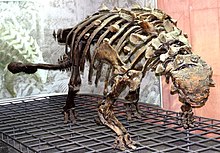Ankylosaurian
| Ankylosaurs Temporal range: Middle Jurassic—Late Cretaceous, 167–66 Ma |
|
|---|---|
 |
|
| Mounted skeleton of Euoplocephalus tutus, Senckenberg Museum | |
| Scientific classification | |
| Kingdom: | Animalia |
| Phylum: | Chordata |
| Class: | Reptilia |
| Clade: | Dinosauria |
| Order: | †Ornithischia |
| Clade: | †Eurypoda |
| Suborder: |
†Ankylosauria Osborn, 1923 |
| Subgroups | |
Ankylosauria is a group of mainly herbivorous dinosaurs of the order Ornithischia. It includes the great majority of dinosaurs with armor in the form of bony osteoderms. Ankylosaurs were bulky quadrupeds, with short, powerful limbs. They are first known to have appeared in the early Jurassic Period, and persisted until the end of the Cretaceous Period. They have been found on every continent except Africa. The first dinosaur ever discovered in Antarctica was the ankylosaurian Antarctopelta, fossils of which were recovered from Ross Island in 1986.
Ankylosauria was first named by Henry Fairfield Osborn in 1923. In the Linnaean classification system, the group is usually considered either a suborder or an infraorder. It is contained within the group Thyreophora, which also includes the stegosaurs, armored dinosaurs known for their combination of plates and spikes.
They sported a very small brain size in proportion to their body, second only to the Saurischian sauropods. They were also rather slow moving, largely because of the shortness of the limbs combined with being incapable of running. Their top speed was likely less than 10 km/hour.
All ankylosaurians had armor over much of their bodies, mostly scutes and nodules, with large spines in some cases. The scutes, or plates, are rectangular to oval objects organized in transverse (side to side) rows, often with keels on the upper surface. Smaller nodules and plates filled in the open spaces between large plates. In all three groups, the first two rows of plates tend to form a sort of half-ring around the neck; in nodosaurids, this comes from adjacent plates fusing with each other (and there is a third row as well), while ankylosaurids usually have the plates fused to the top of another band of bone. The skull has armor plastered on to it, including a distinctive piece on the outside-rear of the lower jaw.
...
Wikipedia
